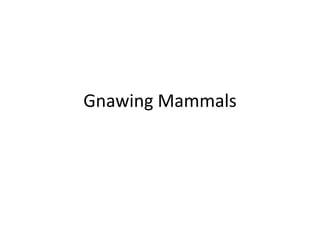Gnawing mammals
•Descargar como PPTX, PDF•
1 recomendación•1,805 vistas
Denunciar
Compartir
Denunciar
Compartir

Recomendados
Más contenido relacionado
La actualidad más candente
La actualidad más candente (20)
Introduction and importance of biological evolution

Introduction and importance of biological evolution
Más de Fauquier Horticulture
Más de Fauquier Horticulture (20)
Gnawing mammals
- 2. Mammals Warm blooded Have a bony skeleton Have a coat of hair Babies drink milk secreted by mothers mammary glands Viviparous - Young are born live (not in eggs)
- 3. Types of Gnawing Mammals Rodents: consists of the following families: Mice, rats, voles Squirrels Marmots & prairie dogs Porcupines Beavers Rabbits, hares, & pikas
- 4. Characteristics of Rodents 4 large incisor teeth Teeth never stop growing Double layers Front edge is sharper than back edge Self sharpen with gnawing Must gnaw to keep teeth worn down
- 5. Gnawing mammals Herbivores Major prey species r-selected population growth Numerous off-spring Low parental care Early reproduction Short life-span & high mortality Maximum population below carrying capacity